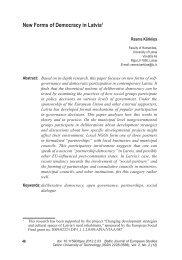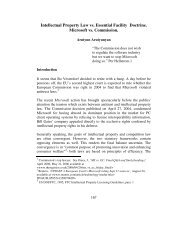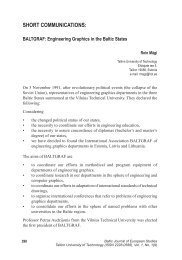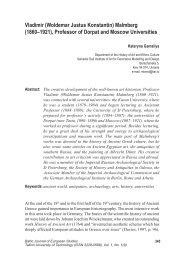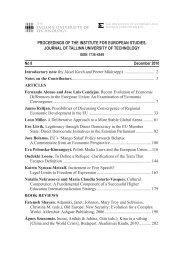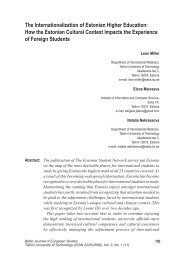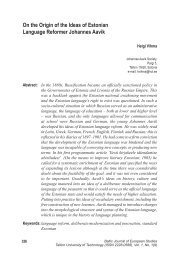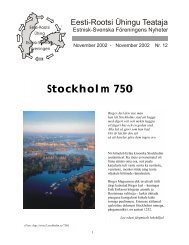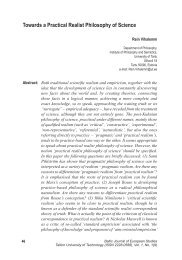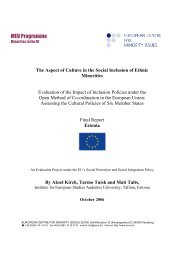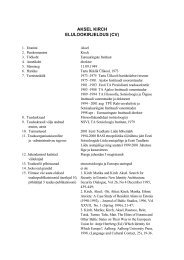Botanical Garden of the university of tartu (dorpat) - The Institute for ...
Botanical Garden of the university of tartu (dorpat) - The Institute for ...
Botanical Garden of the university of tartu (dorpat) - The Institute for ...
You also want an ePaper? Increase the reach of your titles
YUMPU automatically turns print PDFs into web optimized ePapers that Google loves.
Heldur Sander, Toivo Meikar<br />
working as an assistant director <strong>of</strong> <strong>the</strong> <strong>Botanical</strong> <strong>Garden</strong> during ei<strong>the</strong>r his studies<br />
or study breaks. Since 1837, he worked as a practicing physician in Jelgava.<br />
Bärnh<strong>of</strong>f (1812–1855) studied medicine in Tartu in 1831–1835, worked as an<br />
assistant director <strong>of</strong> <strong>the</strong> garden <strong>for</strong> a brief period after his graduation and as a<br />
physician in Alūksne (Marienburg, Latvia) since 1838. Seetzen (1810–1885)<br />
studied medicine in Tartu in 1830–1836, worked as an assistant director <strong>of</strong> <strong>the</strong><br />
<strong>Botanical</strong> <strong>Garden</strong> in 1836–1846 and <strong>the</strong>reafter worked in St Petersburg. Kupffer<br />
studied ma<strong>the</strong>matics in Tartu in 1833–1837 and worked as a private tutor in<br />
Curonia after leaving <strong>the</strong> assistant director’s job in Tartu (Hasselblatt & Otto,<br />
pp. 177, 198, 209, 213, 226; Siilivask, 1982, p. 159). Thus, despite <strong>the</strong> fact that<br />
Ledebour had been requesting <strong>for</strong> years <strong>for</strong> an assistant director’s position to be<br />
allocated, no competent worker who would also be an outstanding researcher<br />
emerged <strong>for</strong> this position after Trautvetter during <strong>the</strong> first half <strong>of</strong> <strong>the</strong> 19 th century.<br />
Ano<strong>the</strong>r assistant director <strong>of</strong> outstanding merit, next to Trautvetter, was Carl<br />
Johann Maximowicz (1827–1892), who graduated from <strong>the</strong> University <strong>of</strong><br />
Tartu in 1850 as a student <strong>of</strong> Bunge. His two-year period in Tartu is regarded<br />
as preparation <strong>for</strong> his subsequent grand works. After leaving Tartu, he moved to<br />
work as herbarium curator in <strong>the</strong> St Petersburg <strong>Botanical</strong> <strong>Garden</strong> (1852–1855,<br />
1858–1859, 1864–1869), where he became <strong>the</strong> head botanist in 1869 and was<br />
elected as <strong>the</strong> temporary director <strong>of</strong> <strong>the</strong> museum and biology laboratory <strong>of</strong> <strong>the</strong><br />
<strong>Botanical</strong> <strong>Garden</strong> in 1870. In 1855–1858 and 1859–1864, Maximowicz worked as<br />
a botanist-explorer. In 1853–1854, he participated in a round-<strong>the</strong>-world expedition<br />
on <strong>the</strong> ship Diana toge<strong>the</strong>r with Leopold von Schrenk and, in 1854–1857, explored<br />
<strong>the</strong> vegetation <strong>of</strong> <strong>the</strong> Amur region. His later expeditions took him to Mongolia,<br />
Tibet, China, Korea and Japan (Trautfetter", 1873, pp. 181–182; Siilivask, 1982,<br />
p. 188; Le Lièvre, 1997b, pp. 131–143; Barnes, 2001, p. 3).<br />
Learned gardeners are known to have changed frequently during Ledebour’s<br />
time. On some occasions <strong>the</strong>re were none working at <strong>the</strong> garden and Ledebour<br />
himself had to do <strong>the</strong> work. <strong>The</strong> only noteworthy learned gardener at this time<br />
was Gebhardt from Riga, who worked in this position <strong>for</strong> a longer period than<br />
<strong>the</strong> o<strong>the</strong>rs (Willkomm, 1873, p. 23). Un<strong>for</strong>tunately, he died in 1832 at <strong>the</strong> age<br />
<strong>of</strong> 29. Gebhardt may have been dealing with <strong>the</strong> plants and herbaria brought<br />
along by Ledebour from his journeys (Le Lièvre, 1997a, p. 40). Gebhardt was<br />
succeeded in <strong>the</strong> position <strong>of</strong> learned gardener by Wilhelm Eduard Stelling, who<br />
started in 1828 as a gardener’s apprentice and later worked as assistant to <strong>the</strong><br />
learned gardener. <strong>The</strong> administration was satisfied in all respects with his work<br />
and he was repeatedly acknowledged <strong>for</strong> <strong>the</strong> excellent order attained in <strong>the</strong><br />
garden (Meikar, 2002, p. 67).<br />
238<br />
Baltic Journal <strong>of</strong> European Studies<br />
Tallinn University <strong>of</strong> Technology (ISSN 2228-0588), Vol. 1, No. 1(9)



